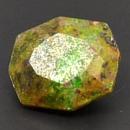|
|
||||||||||||||||
|
||||||||||||||||
|
||||||
|
|
|
|
Sklodowskite
|
|
| | |
| Discovered in 1933; IMA status: Valid (pre-IMA; Grandfathered) | ||
|
| ||
|
Chemistry |
|
|
| |
|
Mg(UO2)2(SiO3OH)2 • 6(H2O) | |
|
|
Hydrated Magnesium Uranyl Silicate |
|
Molecular Weight: |
858.63 gm |
|
Composition: |
Magnesium |
2.83 % |
Mg |
4.69 % |
MgO |
|
|
Uranium |
55.44 % |
U |
62.90 % |
UO2 |
|
|
Silicon |
6.54 % |
Si |
14.00 % |
SiO2 |
|
|
Hydrogen |
1.64 % |
H |
14.69 % |
H2O |
|
|
Oxygen |
33.54 % |
O |
|
|
|
|
|
100.00 % |
|
96.27 % |
= TOTAL OXIDE |
|
|
|
||||
|
Classification |
|
|
| |
|
SILICATES (Germanates) | |
|
8/B.34-10 | |
|
|
9 : SILICATES (Germanates)
|
|
Related to: |
Sklodowskite Group. Also related to the Uranophane Goup. |
|
Members of Group: |
Sklodowskite Group: Cuprosklodowskite, Oursinite, Sklodowskite |
|
Varieties: |
None |
|
Synonyms: |
Chinkolobwite, ICSD 1148, DF 29-875 |
|
|
|
|
Crystal Data |
|
|
|
|
|
Acicular crystals. Prismatic; crystals shaped like slender prisms (e.g. tourmaline) |
|
|
With {001} or {100} as twin plane |
|
|
|
|
|
Physical Properties |
|
|
|
|
|
Perfect on {100} |
|
|
C |
|
|
Brittle |
|
|
2.0 - 3.0 |
|
|
3.45 (g/cm3) |
|
|
None |
|
|
Very Strong; GRapi = 4,205,043.13 (Gamma Ray American Petroleum Institute Units) |
|
|
Health Warning: |
Contains uranium - always wash hands after handling. Avoid inhaling dust when handling or breaking. Never lick or ingest. Avoid prolonged exposure in proximity of the body. Store away from inhabited areas. |
|
|
|
|
Optical Properties |
|
|
|
|
|
Citron-yellow to pale lemon-yellow |
|
|
Transparent to translucent |
|
|
Adamantine to vitreous and silky, earthy when massive. |
|
|
1.613 - 1.657 Biaxial ( - ) |
|
|
0.010 - 0.012 |
|
|
Strong; r > v |
|
|
Visible; X = colorless; Y= yellow; Z = pale yellowish |
|
|
|
|
|
Occurances |
|
|
|
|
|
Geological Setting: |
A rare secondary mineral formed by the action of silica-bearing waters on uraninite or earlier-formed secondary uranium minerals. |
|
Common Associations: |
Kasolite, Soddyite, Torbernite, Uranophane, Uranophane-beta, Novacekite, Metazeunerite, Curite |
|
Common Impurities: |
Te, Ni, Na, K |
|
Type Locality: |
Kalongwe deposit, Katanga (Shaba), Democratic Republic of Congo (Zaïre) |
|
Year Discovered: |
1933 |
|
View mineral photos: | |
|
|
|
|
More Information |
|
|
|
|
|
| |
|
|
|
|
Sklodowskite is a rare uranyl nesosilicate mineral that is very strongly radioactive due to its 55.44 % uranium content. Sklodowskite is formed by the action of silica-bearing waters on uraninite or earlier-formed secondary uranium minerals. Sklodowskite and Uranophane are two closely related minerals that have similar chemistry, structure and crystal habits. Sklodowskite is often closely associated with other radioactive minerals such as Cuprosklodowsite, Curite, Kasolite, Soddyite, Swamboite, Torbernite, Uranophane and Vandenbrandeite. The picture above shows a green gem of yellow Sklodowskite associated with green Cuprosklodowsite, yellow Soddyite and black Vandenbrandeite. This gem is from the Musonoi Mine, Kolwezi, Kolwezi District, Katanga, Democratic Republic of the Congo. Sklodowsite mineral specimens are very attractive with bright yellow crystals set with other brightly colored minerals such as Soddyite. Sklodowskite's bright yellow radiating acicular crystals are very attractive and make an impressive mineral specimen but faceted gems are a true rarity. Sklodowskite was named in honor of Marie Sklodowska-Curie (1867-1934) who, with her husband Pierre Curie, was a pioneer in the study of radioactivity. As with all radioactive minerals always wash hands after handling. Avoid inhaling dust when handling or breaking. Never lick or ingest. Avoid prolonged exposure in proximity of the body. Store away from inhabited areas. Locations for Sklodowskite: from Shinkolobwe, Katanga Province, Congo (Shaba Province, Zaire). In the USA, from the Grants district, McKinley Co., New Mexico; at the Oyler Tunnel claim, near Fruita, Wayne Co., and from the Honeycomb Hills, Juab Co., Utah; in the New Haven mine, Crook Co., Wyoming; and in the Ross-Adams mine, Bokan Mountain, Prince of Wales Island, Alaska. From the Santo Domingo mine, Santa Eulalia, Chihuahua, Mexico. In the Pedra Preta mine, Brumado district, Bahia, Brazil. In the Nabarlek and Koongara uranium deposits and at Rum Jungle, Northern Territory, Australia. In the Rab¶ejac uranium deposit, seven km south-southwest of Lodμeve, H¶erault, France. |
|
|
Sklodowskite gems for sale: We have not photographed our Sklodowskite gems. Please check back soon. |
